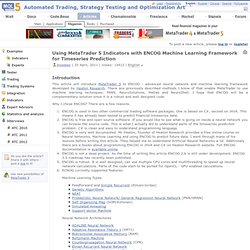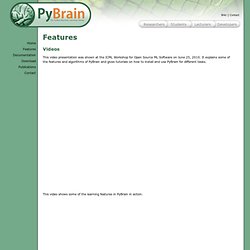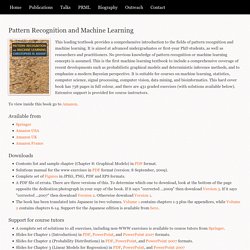

Using MetaTrader 5 Indicators with ENCOG Machine Learning Framework for Timeseries Prediction. Introduction This article will introduce MetaTrader 5 to ENCOG - advanced neural network and machine learning framework developed by Heaton Research.

There are previously described methods I know of that enable MetaTrader to use machine learning techniques: FANN, NeuroSolutions, Matlab and NeuroShell. I hope that ENCOG will be a complementary solution since it is a robust and well designed code. Why I chose ENCOG? There are a few reasons. ENCOG is used in two other commercial trading software packages.
As you can see this is quite a long feature list. This introductory article focuses on feed forward Neural Network architecture with Resilient Propagation (RPROP) training. The knowledge that enabled me to write this article is based on tutorials available on Heaton Research website and very recent articles on predicition of financial timeseries in NinjaTrader. 1. The Artificial Neural Network is a human-engineered algorithm that tries to emulate brain's neural network. BussetiOsbandWong-DeepLearningForTimeSeriesModeling. Using deep learning for time series prediction. Neurolab - Simple and powerfull neural network library for python. Feed-forward neural network for python (ffnet) — ffnet 0.7.1 documentation. PyBrain. Videos This video presentation was shown at the ICML Workshop for Open Source ML Software on June 25, 2010.

It explains some of the features and algorithms of PyBrain and gives tutorials on how to install and use PyBrain for different tasks. This video shows some of the learning features in PyBrain in action. Algorithms We implemented many useful standard and advanced algorithms in PyBrain, and in some cases created interfaces to existing libraries (e.g. Supervised Learning Back-PropagationR-PropSupport-Vector-Machines (LIBSVM interface) Evolino Unsupervised Learning K-Means ClusteringPCA/pPCALSH for Hamming and Euclidean SpacesDeep Belief Networks Reinforcement Learning Value-based Q-Learning (with/without eligibility traces)SARSANeural Fitted Q-iteration Policy Gradients REINFORCENatural Actor-Critic Exploration Methods Epsilon-Greedy Exploration (discrete)Boltzmann Exploration (discrete)Gaussian Exploration (continuous)State-Dependent Exploration (continuous) Black-box Optimization Networks Tools. Cuda-convnet - High-performance C++/CUDA implementation of convolutional neural networks.
Neural networks [3.9] : Conditional random fields - factor graph. Machine learning - Pattern recognition in time series. Welcome — Pylearn2 dev documentation. Warning This project does not have any current developer.

We will continue to review pull requests and merge them when appropriate, but do not expect new development unless someone decides to work on it. There are other machine learning frameworks built on top of Theano that could interest you, such as: Blocks, Keras and Lasagne. Don’t expect a clean road without bumps! If you find a bug please write to pylearn-dev@googlegroups.com. Pylearn2 is a machine learning library. Researchers add features as they need them. There is no PyPI download yet, so Pylearn2 cannot be installed using e.g. pip. Git clone To make Pylearn2 available in your Python installation, run the following command in the top-level pylearn2 directory (which should have been created by the previous command): You may need to use sudo to invoke this command with administrator privileges.
Python setup.py develop --user. Pattern Recognition and Machine Learning Christophe M Bishop. Christopher M. Bishop. This leading textbook provides a comprehensive introduction to the fields of pattern recognition and machine learning.

It is aimed at advanced undergraduates or first-year PhD students, as well as researchers and practitioners. No previous knowledge of pattern recognition or machine learning concepts is assumed. This is the first machine learning textbook to include a comprehensive coverage of recent developments such as probabilistic graphical models and deterministic inference methods, and to emphasize a modern Bayesian perspective. It is suitable for courses on machine learning, statistics, computer science, signal processing, computer vision, data mining, and bioinformatics.
This hard cover book has 738 pages in full colour, and there are 431 graded exercises (with solutions available below). To view inside this book go to Amazon. Available from Downloads Contents list and sample chapter (Chapter 8: Graphical Models) in PDF format. Support for course tutors. PDF: The Elements of Statistical Learning / Data Mining, Inference, and Prediction.